#historic Italian artwork
Explore tagged Tumblr posts
Text

#classical paintings#baroque#dark aesthetic#arthistory#academic art#aesthetic#art history#classical art#classic art#renaissance#painting#art#historical painting#artwork#dark academia#oil painting#dark art#fine art#magdalene grieving#caravaggio#st catherine#the terror#amc the terror#the terror amc#baroque art#baroque painting#james fitzjames#francis crozier#fitzier#italian artists
40 notes
·
View notes
Text

Madonna of the Magnificat by Sandro Botticelli, 1481
#sandro botticelli#boticelli#italian renaissance#renaissance painting#new post#historical#artwork#history#florence italy#uffizi#uffizi gallery#renaissance#religious art#lorenzo de medici#Lucrezia Tornabuoni#Giuliano de' Medici#renaissance art#italian art#catholic art#painting#art
16 notes
·
View notes
Text

Found a book that has a collection of studies, WIPS, sketches and doodles of Leonardo da Vinci
It’s always humanizing to see this type of stuff from historical artists, it’s often lost to time or destroyed by said artists due to perfectionism and not seeing it as meaningful to archive.
#artists on tumblr#artwork#leonardo#da vinci#leonardo da vinci#art history#studies#history#historical#historical art#italian renaissance#renaissance art#renaissance painting#renaissance#itshotasballsinmyhouse
45 notes
·
View notes
Text
When you hear of the statue of David you are more likely to think of Michelangelo's David. When in fact there are four statues of David: one created by Michelangelo, one by Bernini, and two by Donatello— all depicting the same heroine of the classic biblical take, David and Goliath.

David - Donatello, 1403-1409
The first statue was created by Donatello— an Italian early Renaissance artist— “David ca. 1408-1409”. David was commissioned by the Operai del Duomo. Made in marble, the statue stands at 75 inches tall.

David - Donatello, 1435-1440
The second statue, also made by Donatello, was created around 1435-1440, the date is still debated by art historians. This David was commissioned by the Medici family— a family from Italy with strong political ties and are known for commissioning many of the world's most famous artwork (such as “Botticelli's Birth of Venus ca. 1484-86” and “The Annunciation by Fra Angelico ca. 1443”)
Donatello's second David was created in bronze. A freestanding nude sculpture depicting David— a young boy victorious with Goliath's severed head at his feet. Many believe David to be portrayed as naked to show how he has bared himself before God, and to show his immaturity, unlike the David's later created by Michelangelo and Bernini. David resembles the classical Greek sculptures while maintaining the ideals of 15th century Florentine art.

David - Michaelangelo, 1501-1504
The third artwork created is by Michaelangelo— arguably one of the most famous sculptures in the world. Michaelangelo's David is a classic example of high Italian Renaissance and classical antiquity— carved out of marble and depicting biblical figures. Created between 1501-1504, this David depicts a grown man despite the original story being about a boy no older than 16 years old. No doubt Michaelangelo wanted to express masculinity and muscle, a trait of his artworks. This David is the only piece to completely omit any trace of the giant Goliath. In contrast to Donatello's David, standing victorious over Goliath's head, this David is before the battle has happened— he wears a wary face, anxious for the battle to come.

David - Bernini, 1623-1624
Fourth David was made by Bernini, over the course of 8 months from 1623-1624. Bernini was an early baroque artist known for his sculptures and architecture. The story of David and Goliath was a popular subject in the Italian Renaissance, yet the four popular sculptures are different in major ways we might not realize— Donatello's David depicted him victorious after battle, Michaelangelo's David anxious before battle, and Berninis’ in the act of throwing the pebble that takes down Goliath. Another big difference between Berninis' David compared to the older depictions of David is how Bernini sculpted David mid action— contorting his body to throw a pebble at his foe. Berninis David was created using the lost-wax method— a long process that takes building the sculpture out of wax first before creating the mold and casting— and casted in marble.
My favorite sculpture of David is the second by Donatello. Which is yours?
This was a relatively short run down of the famous David sculptures so I am sure there's plenty of details I have left out and I'm sure there are more than 4 sculptures of David but these are just the most well known. perhaps I'll go over them in a later post.
#artwork#italian art#italian renaissance#italian baroque#bernini#michaelangelo#donatello#sculpture#historical art
3 notes
·
View notes
Text

LA ROCCA DEI FILM IN ABRUZZO THE MOVIES FORTRESS IN THE ABRUZZO REGION Una illustrazione dedicata a uno dei luoghi più suggestivi dell'Abruzzo: Rocca Calascio. Così affascinante da essere stata più volte utilizzata come set cinematografico, questa roccaforte torreggia su un rilievo all'interno del Parco nazionale del Gran Sasso e Monti della Laga, avvolta in un'atmosfera a tratti fiabesca.
Segui il richiamo del lupo fino al negozio on- line di #viaggievillaggi e troverai una raffinata stampa su carta perlata da 230gr pronta per arredare il tuo spazio. Eccola qui - - - - - - - - - - - - - - - An illustration dedicated to one of the most striking places in the Abruzzo region: Rocca Calascio. So fascinating that it has been used as a film set several times, this fortress towers on a relief within the Gran Sasso e Monti della Laga National Park, wrapped in a fairy-tale atmosphere.
Follow the wolf's howl to the "Viaggi e Villaggi" shop and you will find a print on 230g pearlescent paper ready to furnish your space. Discover it
#abruzzo#paesaggioitaliano#rocca calascio#stampa da appendere#illustrazione di viaggio#illustrazione digitale#borghi storici#parco nazionale del gran sasso e monti della laga#italia da scoprire#appenino centrale#tramonto#set cinematografico#arredo#decorazione di interni#carta perlata#italian landscapes#discovering italy#italian places#historical villages#gran sasso laga national park#digital illustration#travel illustration#illustration art#furnish#movies set#intern decoration#sunset#ancient fortress#artwork#print on paper
2 notes
·
View notes
Photo

Finally getting around to posting the Tumblr version of an exchange treat I made for @knuttydraws. Renaissance AU of Knutty’s Farie and Rylen. They’re wearing ensembles based on 1490s Italian court ensembles from Milan. The embroidery and sleeve textiles are traditional Lemko motifs, a nod to Farie’s character design. Rylen’s brocade is based on 15th century Italian fabric at the Metropolitan Museum of Art in NYC. I LOVED painting these two together <3
AO3 version here! <3
#dragon age#dragon age inquisition#dragon age fan art#fan art#farie lavellan#knight captain rylen#Renaissance Fashion#renaissance#historical fashion#renaissance au#1490s#15th century#italian renaissance#lemko embroidery#digital art#digital watercolor#my art#my artwork#musetta draws
38 notes
·
View notes
Text
“I’m too old to be in love with a cartoon character” people are like 90 years old in love with the Mona Lisa n her beauty still and she’s just a cartoon character
#art#people love art#people love characters#mona lisa#italian renaissance#leonardo da vinci#manga#art museum#art musuem#fine art#cartoon art#art manga#anime and manga#art history#artwork#artist#historical art#vintage art#the mona lisa#renaissance#oil paint
5 notes
·
View notes
Text
Omg this is such a cute concept.. I kinda want to draw Etruscan pottery based characters now… maybe I will…

consider: golem but as an Etruscan vessel
#art#drawing#artblr#artists on tumblr#artwork#digital art#digital drawing#digital illustration#digital aritst#etruscan#pottery#history#historic#Etruscan pottery#sfw furry#furry#dog#art history#3rd century#Greek#Italian#greek tumblr#furry art
487 notes
·
View notes
Text
♯ JEALOU$Y ; theodore nott
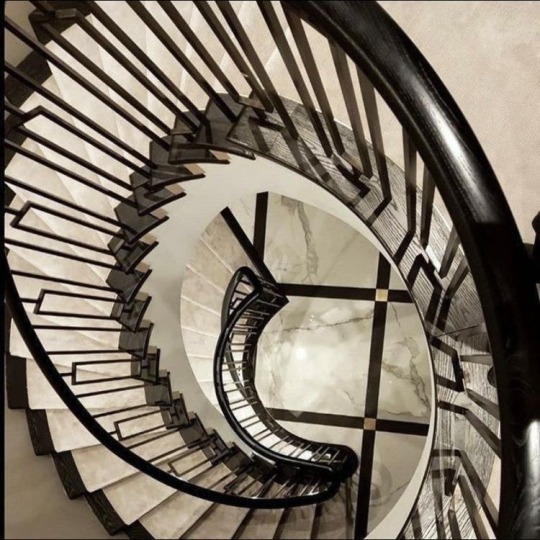



PAIRING! theodore nott x fem!reader
SYNOPSIS! an unexpected situation catches you off guard in the heart of florence and your boyfriend reveals a side of him you’ve never seen before (based off this req.!!)
WARNINGS AND TAGS! fluff, jealous + italian theo, translation of foreign language + lmk !
WORD COUNT! 1.3k
NOTES! he’s so fine when he’s jealous❕
HARRY POTTER MASTERLIST!
© ahqkas — all rights reserved. even when credited, these works are prohibited to be reposted, translated or modified

THEODORE NOTT WAS FAR FROM HAVING A SHORT TEMPER (UNLIKE HIS BEST FRIEND) BUT THAT DIDN'T MEAN HE WAS NECESSARILY CARELESS. Sometimes, jealousy wrapped around his heart like the snake representing his house, squeezing and picking at the muscle, giving it wounds for blood to shed from.
And every time he tried to push those feelings aside, they came back even stronger than before in a crashing wave full of raw emotion. He felt like a puppet on a string that was pulled tight by the cruel hands of jealousy. His actions were no longer his own.
The summer sun bathed the picturesque streets of Florence in a warm, golden glow, casting a honeyed hue over the ancient city. Cobblestone pathways, worn smooth by centuries of footsteps, stretched along the bustling streets. Each turn revealed a new delight: charming cafés with wrought-iron tables spilling onto the sidewalks, historic landmarks standing as silent reminders of the past, and vibrant marketplaces bursting with life and color. The air was rich with the scent of blooming flowers, mingling with the earthy aroma of aged stone and the tantalizing whiff of fresh espresso. The fragrance was an intoxicating blend, making every breath feel like a taste of paradise. The sounds of Florence added to the sensory feast: the melodic chatter of locals and tourists, the clinking of glasses and cutlery from the outdoor restaurants, and the distant strains of street musicians playing heavenly tunes on their violins and accordions.
Florence, in the embrace of summer, was absolutely beautiful. It was a place where history and romance intertwined, where every corner held a new discovery, and every moment was a celebration of the beauty of life. The city's magic lay not just in its landmarks, but in the way it made you feel — alive, enchanted, and eternally in love with the world around you.
You walked hand in hand with Theodore, your fingers intertwined in one as you explored the enchanting city. This vacation had been his idea, a chance for the two of you to escape the pressures of Hogwarts and immerse yourselves in the beauty and romance of Italy. Theo's Italian heritage made the trip even more special; he was eager to show you the places that held a special place in his heart.
As you wandered through a bustling street, you paused to admire a street artist's breathtaking paintings. The vibrant colors and detailed brushstrokes captured the scenery of Florence in ways that made the city's beauty stand out even more, and you found yourself lost in the artwork. Theo had stepped away momentarily to get you both something to eat from a nearby stand, leaving you alone but content. The hum of the city buzzed around you, voices of people blending with the occasional strum of a guitar.
While you were engrossed in the art, a group of local boys approached, their laughter and chatter filling the air. They were handsome and confident, their flirtatious smiles and easy charm unmistakable. One of them, with dark, curly hair and a mischievous grin, stepped forward, clearly intent on catching your attention. His eyes sparkled with interest as he gestured towards you.
"Sei molto bella." ("You are very beautiful.")
You blinked, a bit taken aback. Although you had picked up a few phrases during your time with Theo, your grasp of the language was far from fluent. You understood enough to know that he was complimenting you, but the exact words of meaning escaped you.
Before you could respond, another boy joined in, his tone equally playful. "Vuoi venire a fare una passeggiata con noi?" ("Do you want to go for a walk with us?")
You felt a flush rise to your cheeks, both from the unexpected attention and your inability to respond. Your eyes darted around, hoping to spot your boyfriend. You were feeling increasingly uncomfortable, unsure how to extricate yourself from the situation.
Just as you were about to attempt a polite but awkward decline, you heard Theo's voice, sharp and commanding. "Ehi, lasciatela in pace!" ("Hey, leave her alone!")
The transformation in him was startling. Theo, usually so calm and composed, had a fierce intensity in his eyes. He stepped between you and the group of boys, his posture protective, his expression a stormy mix of anger and determination. The easygoing demeanor he often sported was replaced by a fierce warning.
His broad shoulders squared, blocking the boys' view of you completely, creating a barrier that was both physical and emotional. The bright warmth of the sun seemed to dim in comparison to the fire that burned in Theo's gaze. It was as if a switch had been flipped, transforming him from the gentle, sweet boyfriend you knew into a guardian ready to defend the owner of his heart and soul.
The boys, who had moments ago been brimming with confidence, raised their hands in mock surrender, laughing nervously. "Calmati, amico. Non volevamo causare problemi," one of them said, trying to diffuse the situation. ("Calm down, friend. We didn't want to cause trouble.")
But Theo wasn't having any of it. Each word was a blade of a dagger, cutting through the casual flirtation of the boys, leaving no room for doubt about his intentions. "Non vedete che non è interessata? Andatevene prima che mi arrabbi davvero." ("Can't you see she's not interested? Walk away before I really get angry."). His voice was low and menacing as he continued in rapid Italian, his words too fast for you to catch but clearly effective in making the boys rethink their approach. They muttered a few apologies before scurrying away, casting wary glances over their shoulders.
Theo turned to you, his eyes softening instantly as he took in your bewildered expression. The fierce protector you had just witnessed melted away, replaced by your sweet boy you knew so well. "Are you okay?" His hand found yours, fingers intertwining in a comforting touch.
You nodded, still a bit shaken. "I'm fine. They were just . . . I didn't understand what they were saying," you admitted, feeling a bit embarrassed.
Theo's lips curved into a reassuring smile. "They were trying to flirt with you," he explained. "But don't worry, they're gone now."
You managed a small laugh, the tension easing out of your body. "I figured that much," you said, your voice lightening. "Thank you, Theo."
He stepped closer, wrapping an arm around your shoulders and pulling you into his side. The warmth of his embrace and the steady beat of his heart were instantly calming. "I'm sorry if I scared you," he murmured, his breath brushing against your hair. "I just couldn't stand the thought of them bothering you."
You looked up at him, your eyes meeting his. The fierce protectiveness in his gaze had melted into something softer, more tender. "You were amazing," you said honestly. "I've never seen you like that before."
Theo's smile widened, a hint of pride in his expression. "Well, I can't help it," he said, his tone teasing but sincere. "You bring out the best in me."
As you continued your walk through the beautiful streets of Florence, Theo kept you close, his arm securely around you. The incident with the local boys faded into the background, replaced by the joy of being together in such a magical place. The city's charm and Theo's unwavering affection made you feel like you were living in a dream.
Later that evening, as you sat together at a cozy café, sipping on rich Italian espresso, you couldn't help but feel grateful for Theo. His protective nature, his deep love for you, and his ability to make you feel safe and cherished were all things you treasured deeply. As the sun set over the Florence skyline, painting the sky in brilliant hues of pink and orange, you leaned into Theo, feeling utterly content.
In that moment, with the world bathed in the soft glow of twilight, you knew that no matter where you were, as long as you were with Theo, you were home.
#theodore nott x reader#theodore nott x y/n#theodore nott x you#theodore nott fluff#theodore nott oneshot#theodore nott fic#theodore nott fanfiction#theodore nott imagine#theodore nott drabble#theodore nott#theo nott fic#theo nott one shot#theo nott x reader#theo nott imagine#theo nott fanfiction#theo nott x y/n#theo nott x you#theo nott fluff#theo nott#x reader#reader insert#harry potter imagine#harry potter x reader#slytherin boys#slytherin x reader#harry potter fanfiction#slytherin boys x reader#slytherin#harry potter x you#hp x you
3K notes
·
View notes
Text
Some Art Vocabulary

Abstract - Simplified, intended to capture an aspect or essence of an object or idea rather than to represent reality.
Amber - Tree resin that has become a fossil. It is semi-transparent and gem-like. Amber is used in jewelry today as it has been for thousands of years.
Amulet - Object, organic or inorganic, believed to provide protection and turn away bad luck. Amulets were often worn as jewelry in antiquity.
Anneal - To heat metal to make it soft and pliable.
Black-figure - Technique of vase painting developed in Greece in the 7th and 6th centuries BCE and adopted by the Etruscans. Figures are painted on a reddish clay vase in black silhouette and details are then cut away with a sharp point down to the red below. Sometimes artists added additional colors, especially purple-red and white.
Bronze Disease - Corrosion of a bronze object that cannot be permanently stabilized. Without special care, an object with bronze disease will continue to corrode.
Bust - Portrait of a person including the head and neck, and sometimes the shoulders and part of the chest.
Cameo Glass - Glass produced by layering two or more colors of glass. Generally, an upper layer of white stood out against a contrasting lower background, usually blue.
Cameo Stone - Hard stone, such as agate, naturally layered with bands of color. Artists took advantage of the layers to carve figures or decoration from an upper layer (or more than one), leaving a background layer of a different color.
Cast - To make in a mold from liquid metal. A cast object can be hollow or solid.
Chasing - Technique of adding definition and details to an image or design on metal from the front using blunt and sharp tools.
Conservator (of antiquities) - Professional responsible for preserving ancient objects and materials. Conservators usually have a general knowledge of chemistry and of ancient art-making practices and are often specialists in one material. Among many other responsibilities, they conduct technical and historical research and oversee preventive care such as climate control.
Contrapposto - (”opposite” in Italian) Pose of a standing figure with most of the weight on one leg and the other bent. This causes hips, shoulders, and head to shift in order to balance the body. One arm is often higher and one lower.
Emery - Hard, dense rock rich in corundum, found easily on the Cycladic Islands. A powerful abrasive for grinding and smoothing other stones.
Encaustic - Technique of painting using colored pigments mixed with wax. The waxy mixture was worked with a tiny spatula.
Gild - To apply a thin layer of gold foil or liquid gold (gilt) to create the look of solid gold.
Iconography - Study of and use in art of repeated images with symbolic meaning.
Incise - To press or cut into a surface (stone, metal, clay, wood) with a sharp tool to write text or create fine curving and linear details.
Inlay - To decorate an object by inserting a piece of another material into it so that it is even with the original surface.
Low Relief - Method of carving figures or designs into a surface so that they are raised slightly above a flat background.
Mosaic - Technique and type of artwork. The technique is to arrange cubes of stone, glass, and ceramic to form patterns and pictures in cement, usually on a floor. The artwork is the final story or decoration made of cubes.
Mummification - Process of preserving a body by drying it. The Egyptians removed internal organs and put natron, a natural mineral mixture, on and inside the body. This absorbed moisture and prevented decay.
Palmette - Stylized palm leaf used as decoration in ancient Greek and Roman art and architecture.
Pentelic - From Mount Pentelicus, near Athens. An adjective that mostly refers to the beautiful white Greek marble marble in its quarries.
Portrait - Image of a person, usually the head and face. Some portraits include part of the chest or show the whole body. The image may closely resemble a person or emphasize, idealize, or invent characteristics.
Repoussé - Technique of raising the outline of a design on metal by repeatedly heating and softening the metal and pushing the desired shapes into it from the back with a blunt tool.
Sarcophagus/Sarcophagi (pl) - Stone coffin, often decorated on the sides with mythological scenes carved in relief, sometimes with the image of the deceased person or couple on the lid. Used in Imperial Roman times from the early 100s into the 400s CE.
Stele/Stelai (pl) - Upright stone or wooden slab or pillar used to honor a person or mark a place. Often an inscribed grave marker or a boundary stone. (Also called stela/stelae.)
Syncretism - Blending of elements of different cultures, often resulting in new imagery or new interpretations.
Tessera/tesserae (pl) - Pieces of stone or other hard materials cut into squares or cubes to make mosaic art.
More: Word Lists ⚜ pt. 2
#art#terminology#word list#writeblr#dark academia#writing reference#spilled ink#literature#writers on tumblr#writing prompt#poetry#poets on tumblr#writing inspiration#creative writing#light academia#langblr#linguistics#jan matejko#romanticism#art vocab#writing resources
258 notes
·
View notes
Text
The biggest Easter egg yet
I’ve been meaning to address this for a while now, but @camdenleisurepirates gave me the final push after reading my piece on Gabriel’s cross. Huge thanks for that morsel of motivation, my ADHD brain loves you.
This is going to be yet another long read, although not as extensive as my bookshop statues meta. Still, better get yourself some hot chocolate or another drink of your choice and make sure you’re comfortable!
Now, remember the X-Ray interview with Peter Anderson on Easter Eggs in the opening animation he created for the second season? Forget red herrings, apparently our fandom has a literal red phone box! I’m convinced that this whole scene is a one big — the biggest, actually — Easter Egg, and I’ll explain why step-by-step.
The red phone box Crowley used to warn Aziraphale about the Antichrist and the following Armageddon in S1, the exact one where he left change for an emergency call, seems important enough in terms of the future S3 plot, but there’s so much more going on in this frame. Not only the lift.
The angels
At the very start of this sequence we can see a fragment of an elaborate bridge guarded by cherubs sitting on two columns, maybe globes, leading to a distant structure built over a literal mountain of trash — all elements of the S1 and S2 openings which were consciously picked out by the animators and put together in a very ominous pile.
Ready for some scavenging?
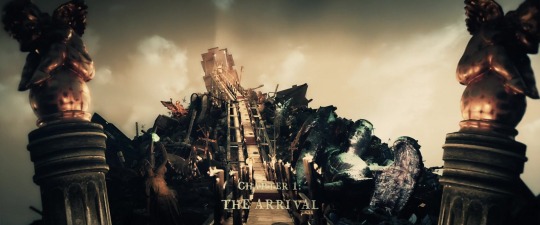

In the Gabriel’s cross meta, I already mentioned the importance of Ponte Sant’Angelo in relation to the ex-Archangel’s statue. Now it’s time to widen our perspective and focus on the full picture — quite literally. Apparently the bridge from the opening sequence has ten statues of angels, exactly as the Italian historical monument.
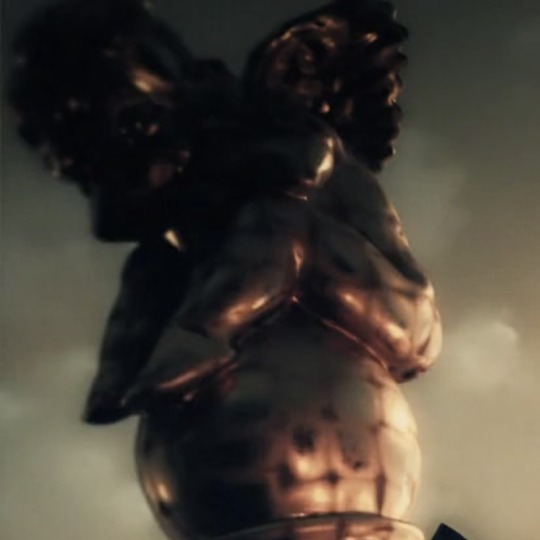
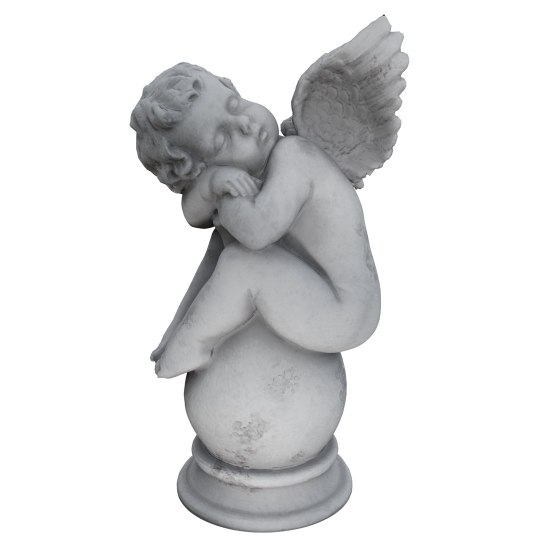
First things first though: the two big cherubs guarding the entry to the bridge might seem familiar to some of you. While they’re obviously not copies of the same statue, a very similar pair of brass cherubs is placed in Aziraphale’s bookshop to symbolize Aziraphale and Crowley. And looking at the screenshot above and the way they sleep or sulk with their backs turned on each other, they are most certainly not talking. The addition of more than one set of eyes is a lovely reference to biblically accurate angel memes though.
If we assume the traditional left-right positioning of the characters, Aziraphale is on the left and Crowley is on the right. Directly behind Aziraphale we can see a ship named “Good Traits”, but in reverse — kinda sorta confirmed by the animator Peter Anderson to be connected to the concept of the seven deadly sins on Twitter. Same that was mentioned recently by Neil in one of his asks.
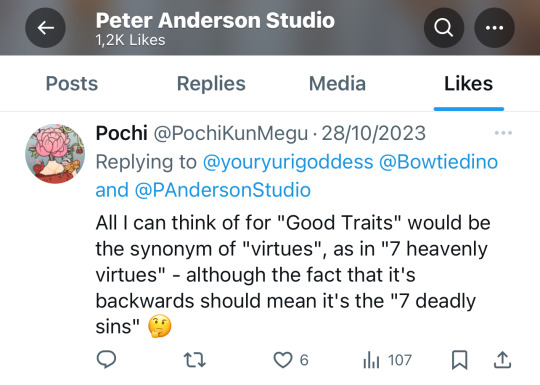
The presence of Gabriel — a renegade Archangel wielding a broken cross — on the right, Crowley’s side, seems to match this theory. It could also support one of the possible interpretations of the very last bookshop shot in the S2 finale.

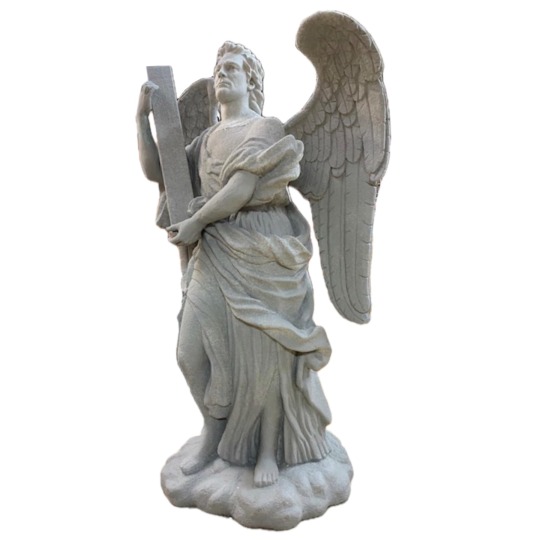
Out of all ten statues, Angel Carrying the Cross by Ercole Ferrata is considered inferior to the others on the bridge in that it appears to be a two-dimensional relief sculpture rather than an unbounded three-dimensional artwork, which seems to match Gabriel’s first impression as a character.
The inscription on the statue reads, “Dominion rests on his shoulders" — that is the weight of the cross that Christ was forced to carry through Jerusalem before being crucified. Even though Gabriel’s burden partially disappeared, the whole bridge and its environment is covered with crosses. It’s clear that we’re looking at a direct parallel of Via Crucis, the Way of Sorrows.
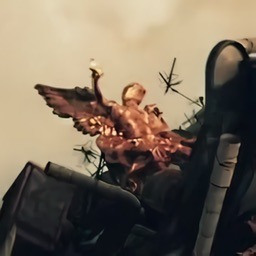
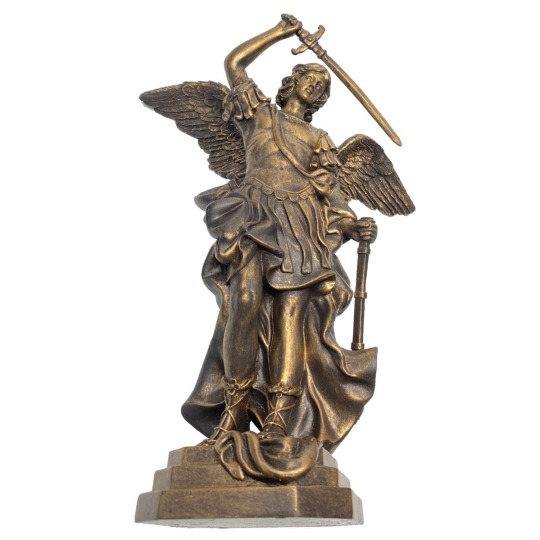
Towering over the Italian bridge, at the very top of Castel Sant’Angelo, is a statue of Archangel Michael, seen as the golden angel on the top left part of the trash pile. Aziraphale’s side, perhaps as his assistant, perhaps a rival? Legends of the Jews mention Michael as the chief of a band of angels who questioned God's decision to create man on Earth. The entire band of angels, except for Michael, was condemned to Fall — which could explain why they have such a good access to the Grapevine That Obviously Doesn’t Exist. And whatever’s going on between Michael and Dagon, perhaps.
In Roman Catholic teachings, Michael has four main roles or offices. Their first role is the leader of the Army of God and the leader of Heaven's forces in the final triumph over the powers of Hell. Viewed as the angelic model for the virtues of the spiritual warrior, their conflict with evil taken as the battle within. The second and third roles of Michael deal with death. Their second role is that of an angel of death, carrying the souls of Christians to Heaven. Michael descends at the hour of death and gives each soul the chance to redeem itself before passing; thus throwing the devil and his minions into consternation. In their third role, Michael weights souls on perfectly balanced scales they are often depicted with as their attribute. In their fourth role, Michael appears as the guardian of the Church. Might be the reason why they’re the closest to the building on top of the mountain.
It looks like Michael lost their sword though, just like Gabriel lost a part of the cross he was supposed to carry. The sword in question was supposed to be used to slay the dragon — Satan, the Adversary — according to John of Patmos and his Book of Revelations.
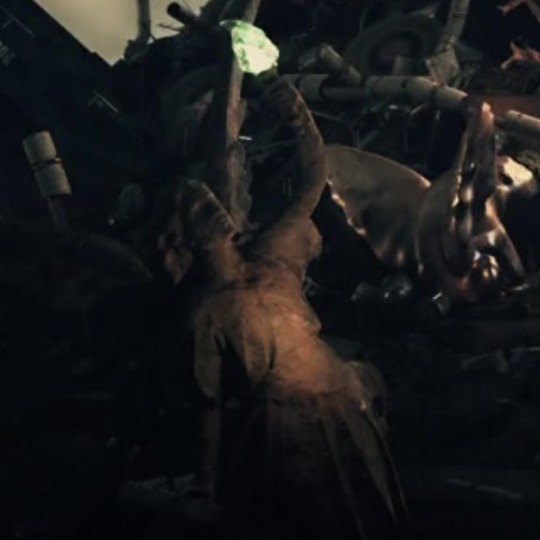
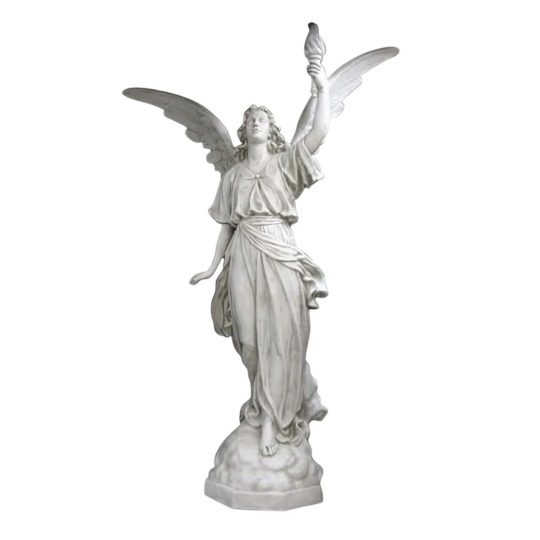
Speak of the devil: interestingly, there are two copies of an anonymous variation of the Angel of Light statue appearing twice on both sides of the bridge. Both the title as well as the statue itself seem like obvious references to one (former) angel literally called the Lightbringer, Lucifer. Perhaps one of them is representing his son, the Antichrist, instead, with the both of them helping out the Ineffables on two opposing — or perhaps only parallel — sides of the bridge?
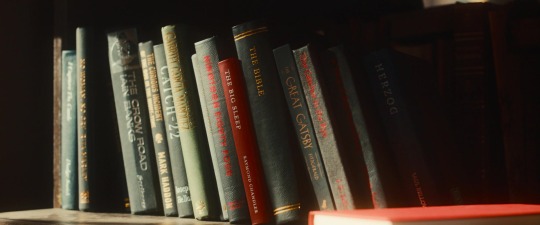
The light carried by Lucifer appears to be green, a color used in the series as a visual representation of Hell, but on the intertextual level might also serve as a reference to F. Scott Fitzgerald’s classic novel The Great Gatsby and the green light at the end of the Daisy’s dock symbolizing the undying love, desperation, and longing for an unattainable dream. In the story, the color represents the limitations of power and money. Not surprisingly, the novel appears on Jim’s bookshelf and is part of the Good Omens book club — a list of personal recommendations from Neil Gaiman and Douglas Mackinnon for the fans to catch up on before the next series.
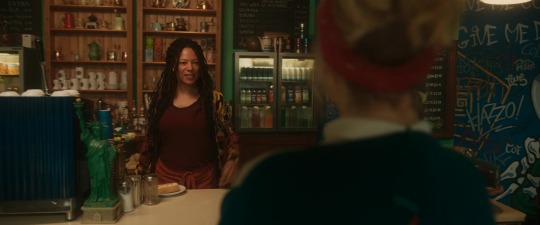
Last but not least, the possible connection to Libertas as the inspiration for the Statue of Liberty, shown multiple times in S2 as a foreshadowing of our character’s trip to America in S3. The related quote of Patrick Henry “Give me liberty or give me death” becomes even more relevant if we consider how the motto of the French Revolution was sometimes written as Liberté, égalité, fraternité ou la mort (“Liberty, equality, fraternity or death”). A lesson surely learnt by a certain angel back in 1793, when he was held prisoner for the last time before being forcefully taken Upstairs in the Final Fifteen.
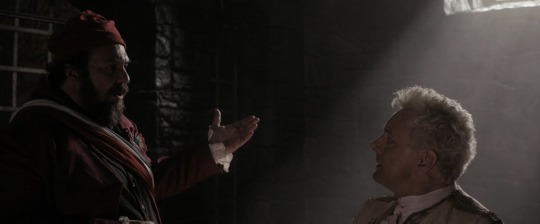
The bridge and the castle
Okay, these are the basic observations. Now a brief historical overview and we will reach the fun bit in a jiffy.
Have you ever wondered about the meaning of this whole complex? It wasn’t always angelic, but named after a Roman noble dynasty. The Aelian bridge was built by the Emperor Hadrian in 134 AD to span River Tiber from the city center to his mausoleum. With time, the remains of more emperors were put to rest in there, until it was plundered and destroyed in a war. Then the remaining structure was transformed into a military fortress and a castle serving as the papal residence in times of war.
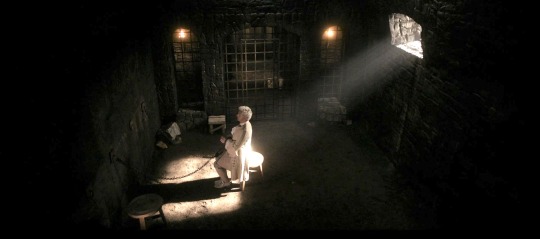
The Papal State also used Sant'Angelo as a prison; the Renaissance philosopher Giordano Bruno was imprisoned there for six years. Executions of the inmates were performed in the small inner courtyard, but they weren’t the only deaths in the area. On the other side of the bridge, in the adjoining Piazza del Ponte, under the watchful eyes of the stone likenesses of two saints, the public executions were held, and the heads of the criminals were brought onto the bridge and exposed to public view there.
As a prison, the former mausoleum is also the setting for the third act of Giacomo Puccini's 1900 opera Tosca. Long story short, the eponymous heroine convinces her lover to feign death so that they can flee together. Unfortunately, they are betrayed and the firing squad shoots at him with real bullets instead of blanks. Tosca believes in the quality of his acting performance rather than the truth, and when the realization hits her, she leaps to her death from the Castel’s ramparts.
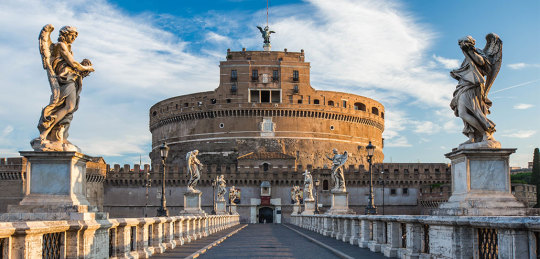
After Nero’s bridge was destroyed, the travelers were forced to cross this bridge as the only direct route to the Vatican and St Peter’s Basilica, earning it the nickname “the bridge of Saint Peter”. That’s why in the 16th century Pope Clement VII erected statues of Saints Peter and Paul at the ends of the bridge, guarding it as they are supposed to protect the entry to Heaven.
In 1688 the bridge was embellished with ten angel statues, five on each side of the bridge, carrying Arma Christi, the Instruments of the Passion. The Good Omens characters represented by those statues in the opening sequence might be other instruments of Christ’s suffering as parts of the system that needs to be overthrown or replaced.
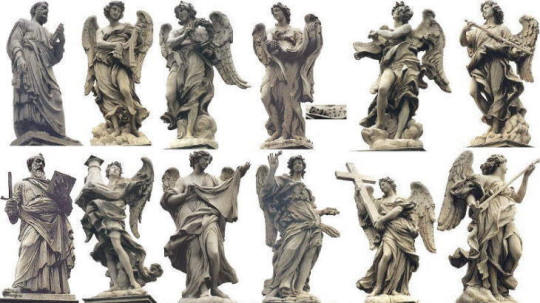
One angel appears particularly important in the context of both the bridge and the Second Coming — Saint Michael the Archangel.
Legend holds that the Archangel Michael appeared atop Hadrian’s mausoleum, sheathing their sword as a sign of the end of the plague of 590, thus lending the castle its present name. A less charitable yet more apt elaboration of the legend, given the militant disposition of this particular Archangel, was heard by the 15th-century traveler who saw an angel statue on the castle roof. He recounts that during a prolonged season of the plague, Pope Gregory I heard that the populace, even Christians, had begun revering a pagan idol at the church of Santa Agata in Suburra. A vision urged the Pope to lead a procession to the church. Upon arriving, the idol miraculously fell apart with a clap of thunder. Returning to St Peter's by the Aelian Bridge, the Pope had another vision of an angel atop the castle, wiping the blood from his sword on his mantle, and then sheathing it. While the Pope interpreted this as a sign that God was appeased, this did not prevent Gregory from destroying more sites of pagan worship in Rome. In honor of the vision and Michael, the bridge was renamed in their name.
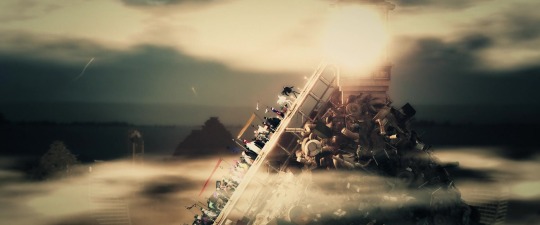
What if the procession from the opening sequence was meant to imitate the procession led by the Pope from the legend? What if Aziraphale, now officially a Supreme Archangel, Commander of the Heavenly Host, is the one actually leading it, with Crowley finally at his side as his partner and second in command, just like it was proposed by him in the Final Fifteen?*
What if by some reason, maybe personal ambition, maybe just a tragic coincidence or situational necessity, there really was an impostor in Heaven, and Metatron — the so called Voice of God who seemingly doesn’t speak up for Herself since Job’s test — has been playing a winged version of the Wizard of Oz all along?
It would make just the perfect sense if not for one tiny detail. The procession we see on the bridge is actually led by Crowley, which doesn’t fit the parallel at all — unless it’s actually a proof of an ongoing body swap, as the mismatched names of the actors could also suggest?
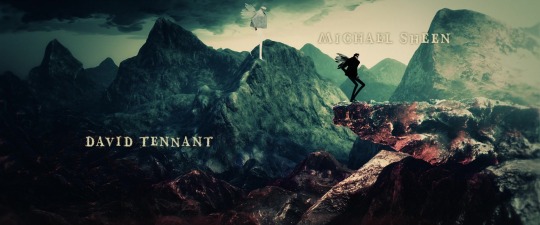
The mountain of trash and the bookshop
The symbolic mountain of trash we can see Aziraphale and Crowley climb is a reference in itself. To an actual mount called Zion, believed to be the place where Yahweh, the God of Israel, dwells (Isaiah 8:18; Psalm 74:2), the place where God is king (Isaiah 24:23) and where God has installed king David on his throne (Psalm 2:6).

In a literal sense, it’s a hill in Jerusalem, although the sources refer to three different locations in different contexts — although for the purpose of this meta the Upper Eastern Hill (Temple Mount) makes the most sense. Its highest part became the site of Solomon's Temple. The same King Solomon the rituals in Freemasonry refer to. Masonic buildings, where lodges and their members meet, are sometimes called "temples" specifically as an allegoric reference to King Solomon's Temple, not actual places of worship. And Aziraphale’s bookshop is built around Solomon’s Magic Circle.
In a metaphysical sense, and especially in the context of the Christian New Testament, it is also believed to be a part of Heaven — the heavenly Jerusalem, God's Holy, eternal city. Christians are said to have “(…) come to Mount Zion and to the city of the living God, the heavenly Jerusalem, to an innumerable company of angels, to the general assembly and church of the firstborn who are registered in heaven” (Hebrews 12:22-23 cf. Revelation 14:1). Just like the procession were following in the opening sequence.
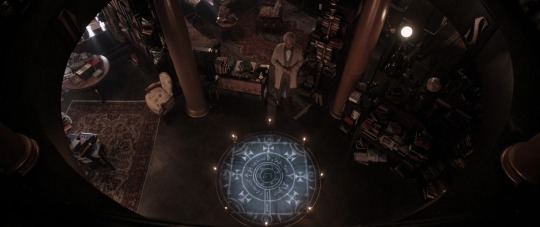
There’s been some speculation whether the lift on top of the mountain could symbolize Aziraphale’s bookshop, or, more specifically, the oculus in its centre. If you look closely at the enhanced screenshot, you can see that the dome isn’t made of glass and that it looks like a tower (a church’s bell tower, perhaps) more than a whole building.
And there is an actual doorway in there — not like the modern lift doors — opening up towards the source of that white, heavenly light. And what kind of enlightenment can you usually find up in the skies or heavens?

We’re welcomed to crack open the doors to the Heavenly Sanctuary — the Most Holy place, Sanctum Sanctorum, the Holy of Holies — to undraw the final curtain and finally stand eye to eye with God. Who knows, maybe even ask some questions or listen to some answers.
Or, at the very least, to meet one of Her forms known as Jesus Christ. Because that’s precisely where he serves as our (humanity’s) Mediator and the Holy Priest after his Ascension to Heaven. The structure at the top reminds of some temple architecture seen in Antiquity and Christianity.

The Catholic Church considers the Church tabernacle or its location (traditionally at the rear of the sanctuary) as the symbolic equivalent of the Holy of Holies, due to the storage of consecrated hosts in that vessel and their meaning as the Body of Christ. Tabernacle is commonly marked with a red light turned on and off depending on His presence or lack if it.
Looks like He’s already in the area, one way or another, keeping eye on some things.
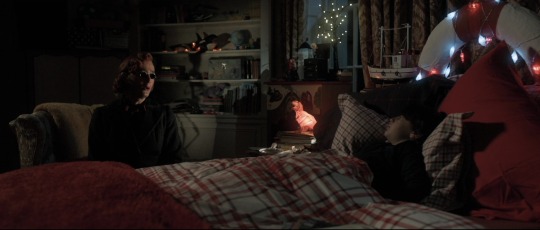

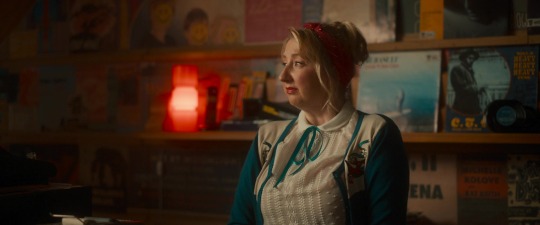
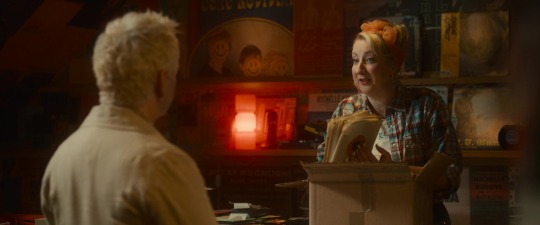
Are we following a procession of believers happy to embrace their one and true Savior? Or are they actually protesters on their way to dethrone the authority and the system?
Guess we will have to wait and see.
#the good omens crew is unhinged#everything has a meaning#title sequence#angels everywhere#archangel fucking gabriel#gabriel’s statue#bookshop statues#statues update#ponte sant’angelo#let there be light#good omens analysis#good omens meta#bible fanfiction#yuri is doing her thing
160 notes
·
View notes
Text

US Returns $80 Million-Worth of Stolen Artifacts to Italy
It looked more like a museum exhibition of Italian art than a crime scene, but in the Central Institute for Restoration’s offices, located inside a former women’s prison in central Rome, some 600 works of art were put on display Tuesday morning.
Ranging from life-sized bronze statues to tiny Roman coins, from oil paintings to mosaic flooring, the pieces span the 9th century BC to the 2nd century AD and amount to just one year’s stolen and trafficked art confiscated by Manhattan prosecutor Col. Matthew Bogdanos’ team and returned to Italy.
The trafficked works, pillaged from the Italian regions of Lazio, Campania, Puglia, Calabria and Sicily, were sequestered in New York and New Jersey last year.
The returned works, together with 60 items repatriated last year, are worth more than $80 million (or roughly €73.6 million) — but are just a drop in the bucket when it comes to artwork still hidden away in private warehouses and on display in museums in the United States, Bogdanos said on the sidelines of a presentation to the media on Tuesday.


Bogdanos said the $80 million of items does not include a further 100 items his team has just seized in the US.
What makes the seizure and return of stolen artifacts so difficult is that authorities often have no idea what they are looking for, according to Gen. D. Francesco Gargaro, commander of the Carabinieri for the Protection of Cultural Heritage.
“When artifacts are taken from clandestine graves, they have never been cataloged,” he said. That means that, in addition to the items themselves, their historical context was stolen, robbing archaeologists of valuable information. (Instead, investigators work backwards, assessing paperwork and provenance claims for artifacts provided by their owners, as well as undertaking technical tests to best confirm a piece’s true origins.)
Most of the recent items returned to Italy were dug out of clandestine excavations or stolen from churches, museums and private individuals, Gargaro said.
Among the items on display on Tuesday was a cuirass and two bronze heads dating back to the 4th-3rd century BC that were confiscated from a gallery owner in New York.
There was also an Umbrian bronze statue depicting a warrior stolen from an Italian museum in 1962 that was found in a well-known American museum.




And a mosaic floor depicting the myth of Orpheus enchanting wild animals with the sound of the lyre from the mid-3rd to mid-4th century AD was recovered after being stolen from a clandestine excavation in Sicily in the early 1990s. It was confiscated from the private collection of a well-known New York collector.
Italy’s Carabinieri Cultural Heritage Protection unit uses artificial intelligence to search for stolen cultural assets under a new program called “Stolen Works Of Art Detection System” (SWOADS), which searches for taken items by scanning the web and social media for images.



“The return to Italy of cultural assets of such importance, both for their numerical consistency and for their historical-artistic value, is another significant achievement, Italy’s culture ministry undersecretary Gianmarco Mazzi said Tuesday.
“In addition to being works of art of inestimable value, they represent the high expression of our history, our culture and our national identity.”
In 2023 alone, 105,474 pieces of art worth more than €264 million (or $287 million) were found and confiscated worldwide thanks to the artificial intelligence project, according to Gargaro.
By Barbie Latza Nadeau.
#US Returns $80 Million-Worth of Stolen Artifacts to Italy#stolen art#looted art#trafficked art#ancient artifacts#archeology#archeolgst#history#history news#ancient history#ancient culture#ancient civilizations#ancient rome#roman history#roman empire#roman art#ancient art
63 notes
·
View notes
Text
Beetlejuice's Backstory and the Black Plague 💚🕷️🥀💀 PART 3

Good evening! As promised, here’s Part 3 of my series on Beetlejuice’s past and movieverse. Today, we dive deeper into historical fashion, analyzing the outfits of Beetlejuice and Delores to uncover their personal stories.
If you missed the earlier parts, check out PART 1 and PART 2.
Warning: This post contains SPOILERS for ‘Beetlejuice Beetlejuice’ (2024)... and many, MANY speculations.
Quick recap: In Part 1, we discussed the Plague. In Part 2, we delved into Beetlejuice’s past, questioning the claim that he died over 600 years ago.
I wondered: is that really true? Why does his clothing reflect the Baroque style, then?
That's right! In Part 3, I confirm my previous point: there are several clues suggesting that Beetlejuice most likely lived during the Baroque era - a cultural movement that began in Rome at the end of the 16th century and faded around 1750. Here is the list of the clues I noticed:
The lace neckband around BJ's neck.
His three-piece wedding suit.
Delores off-the-shoulder neckline and puffed sleeves.
The bird masks used by Delores and the undertakers.
AliveBeetlejuice first outfit (when he's stealing from corpses): specifically, the pirate shirt and the type of shoes.
Keep in mind that most of these elements were revolutionary novelties of the 16th-17th century. Here is proof for every. single. one of them.
The Lace Cravat
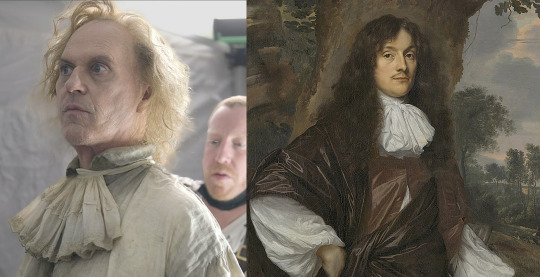
A behind the scenes still of Michael Keaton in 'Beetlejuice Beetlejuice' vs. the portrait of Jacob de Witte, Lord of Haamstede (Netherlands). The artwork was made by Jan Mijtens in 1660.
The first cravat, the predecessor of modern neckties and bow ties, originated in France during Louis XIV’s reign as a political and fashion statement. (Although the early idea comes from the Ancient Roman focale, used around 200 CE). The King was inspired by a particularly eye-catching necktie wore by Croatian mercenaries as part of their uniform. The new article of clothing quickly became a fashion staple for high-ranking men across Europe.
In its use, it represented the evolution of the common handkerchief, already popular in the 1500s as a practical tool, a flirty decoration, and a status symbol. I believe the variant Beetlejuice is wearing in the picture is called ‘jabot,’ and is one of the older, simpler versions.
Lace, often used in cravats, highlighted the wearer’s wealth. Italian lace, especially from Venice, was highly sought after by the European elite since the 15th century, when ruffs and collars were in vogue.
This detail suggests two possibilities:
Beetlejuice might have been an impoverished aristocrat (or a rich merchant) clinging to his title until the end. This could also explain the ring on his index finger, symbolizing power or family ties. Or both.
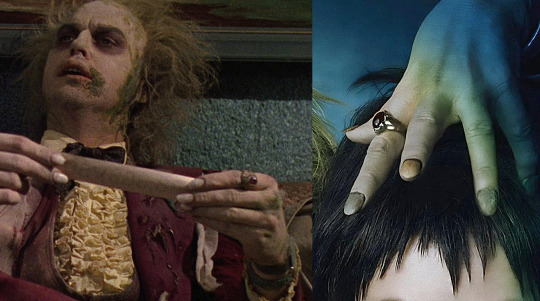
Alternatively, he may have been someone who strongly wished to be part of the elite.
Jacket and Breeches
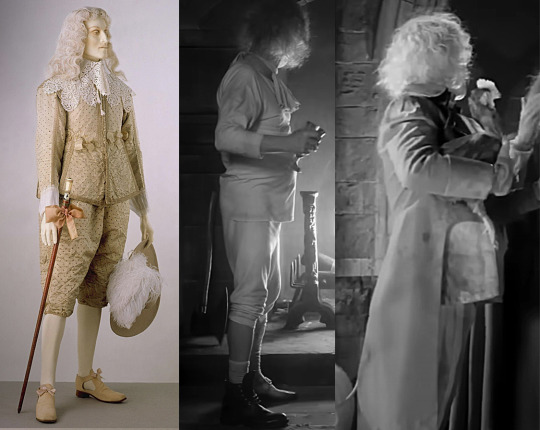
Aristocratic fashion, 1630 (Victoria & Albert collection) vs. What Beetlejuice wore in the wedding scene.
Another standout innovation of the Baroque period was the introduction of the three-piece men’s suit, known as the ‘Habit à la française.’
This ensemble included a tailcoat (a calf-length jacket), a coat (a long waistcoat), and knee-length breeches. Like the cravat, this fashion was adopted across Europe. As you can see, Beetlejuice is perfectly embodying this fashion, which evolved and remained popular until the 19th century. Interestingly, one shoe is missing.
Pirate Shirt
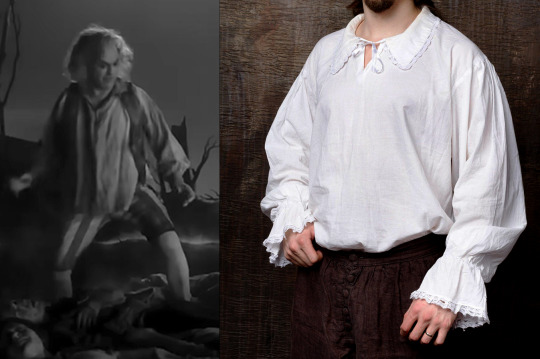
Originating in the 16th-17th century, the ‘poet shirt’ or ‘poet blouse’ remained popular through the Romantic era. These multi-purpose shirts served as both underwear and nightwear, featuring long tails that reached mid-thigh or knee. The body and sleeves were gathered at the collar and cuffs, creating a full, loose fit.
Delores' Outfit

For comparison, I’ve included an illustration of noblewomen’s fashion at the court of Louis XIII (died 1643). His successor, Louis XIV, made France a cultural and fashion beacon for the next two centuries.
In the movie, Delores wears two nearly identical outfits: long dresses with puffed sleeves ending just below the elbow, a corset, and an off-the-shoulder neckline. This style aligns with 17th-century trends when fashion became more comfortable and relaxed.
The black color suits her character’s personality and role in the film, possibly hinting at a connection to the late Renaissance and the Spanish Court.
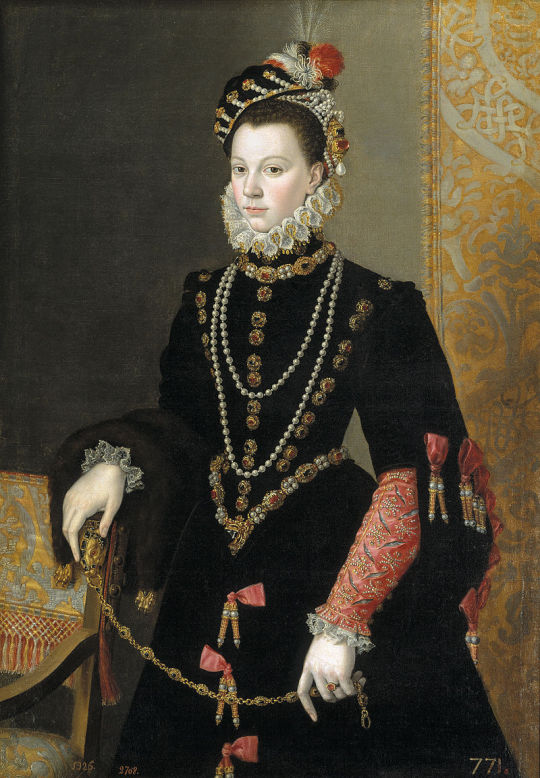

In fact, during the reign of Charles V (1500-1558) and his son Philip II (1527-1598), Spanish aristocracy particularly favored the black color, as it represented austerity and power for both men and women. Additionally, a deep shade of black was particularly difficult to achieve with the dyeing methods of the time, making those fabrics quite expensive to make.
However, The Spanish style was quite the opposite to what France later proposed: it consisted in a severe and somber luxury, which increased in opulence as the time passed. As Spain happened to be the beacon of fashion before Louis XIV came along, it's only natural that black rapidly became quite popular all around Europe as well. The color was particularly appreciated by the members of the middle class in Protestant nations and, apparently, in Italy as well.
Finally, keep in mind that 'Delores' is a variant of the more common 'Dolores'. Both names have Spanish origins and means 'sorrows'.
So what do we think? Was Beetlejuice from a rich family? Was Delores a Spanish witch?
Who knows! But I’m willing to dream and speculate!
Until the big reveal from Tim Burton himself in the now teased but not confirmed yet sequel, have a fantastic week!✨
#beetlejuice movie#tim burton#michael keaton#film theory#film analysis#film stills#cinema#film#movie#beetlejuice#betelgeuse#beetlejuice sequel#beetlejuice beetlejuice#europe#italy#beetlebabes#italian#dark#plaguecore#baroque#17th century#history#renaissance#historical fashion#delores#beetlejuice 2024#black plague#beetlejuice 2#beetlejuice & lydia
28 notes
·
View notes
Note
I don't think we can expect everyone to know a lot about art on a deep level, but I do miss more info in art museums. If there are texts I find that they tend to be very surface level. I think it would be nice if either there just was given more info on the plaques in the museums, or that there would be also a sort of digital tour you could follow on your phone where you could access the info. The digital tour on your phone gives you the possibility to give way more info than you would ever put on a plaque in a museum and you don't have to try to read it with 7 people at once. I just remember that two summers ago I was walking through the National Gallery in London constantly looking up paintings and the historical events/stories they depicted. I do think, with the internet in our pockets, that the people who are interested have so much more access to art and info about them, but I still think that for permanent expositions museums could put in some more effort.
Having info about the painter, the event/story depicted, the symbolism (or interpretation of it), and some info about the materials used per painting would be nice, but I am also aware that that would end up being a huge amount of work. Non-academic people just often don't have access to academic publications, or simply don't know how to access them (I'm writing here in English, and in my experience publications in English are way easier to find for free in some way than those in Dutch, German or French, at least those I've needed, but you still don't find everything).
Interesting! There is an ongoing critical restructuring of the art museum, as they grapple with changing the ways they function. being colonial institutions invented to create a civilizing effect for the uneducated masses who suddenly are no longer at work 15 hours a day is pretty bad, right? the 18th century ruling class was extremely worried about what poor people would do with all the new leisure time + human rights they had gained after all those pesky revolutions. so enter the public, free, national art museums.

This crucial book by Duncan first criticized national art museums as a ritual space to replace the power that the church used to have: you get dressed up nicely, walk into a museum and perform an act of pseudo-worship by ascending up the giant steps, you follow a map that leads you from one room to the next, in chronological order with Italian renaissance art as the most valuable in this little micro world, and the other cultures ranked lower (looted african art at the very bottom, unless its with a picasso). You speak quietly, never point, don't stand too closely, follow the map, and NEVER run. if you step out of this order, the guards and the other guests will get angry and yell to correct you.
The museum takes the low uneducated dirty working class and teaches them how to act proper through a civilizing ritual.
Last night I told my friend a story Barbara Kruger mentions on Katy Hessel's podcast, that she gained her visual culture education in the lowest way possible, in a basement as one of the copy-paste girls who put the ads together at conde nast.


She wanted to go to museums and teach herself more about art, but felt like she could never feel clean enough to go in, her clothes felt too dirty and old. she felt like she needed to be lint rolled first. Many of my students feel exactly the same, "I can't go to the museum in sweatpants"
As a museologist, there's an idea of removing this authoritative condescendingness to art museums, and that starts by making didactics have as little of the curator's voice as possible, with just a tombstone. I'm trained to look at an artwork and immediately know the things you mentioned: the era, materials, iconographies, and the artists biography. communicating that to a student takes an entire hour every week. I do not look at didactics because I already have immediate basic info and context of every artwork, and I want to spend my time looking at the art itself. About 1% of this info is available on google/wiki.
You think museums should have a digital didactic for each object in a permanent collection? That'd be a fun initiative, essentially digitizing the work of the docent educator.
How would you feel about other visitors, instead of lining up to read a long didactic, were lining up to look between their phone and the art for a 10+ mins lecture that theyre playing at volume level 100?
Now how do you feel when I tell you the British Museum alone has over 8 million objects in its permanent collection, and doing a digital explanation for each one would take centuries if every qualified artist historian in the world worked on it.
To bring up Katy Hessel again: she does a great job at bridging this gap! She only has an undergrad level of understanding art but that actually makes her a great art communicator and instagram docent, she explains really basic things every art historian already knows, the 1% of art history you get on wikipedia but through her great voice. Museums Without Men accomplishes what you propose on a one woman level; an audio guide to the best women artists in a museum collection:

23 notes
·
View notes
Text
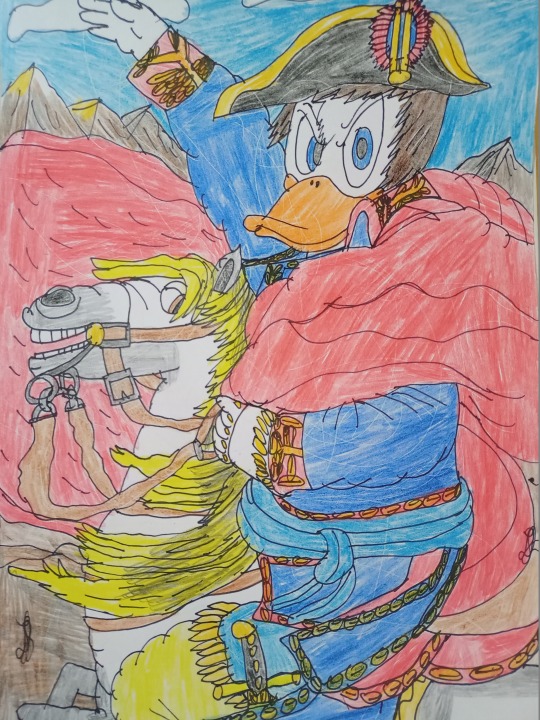
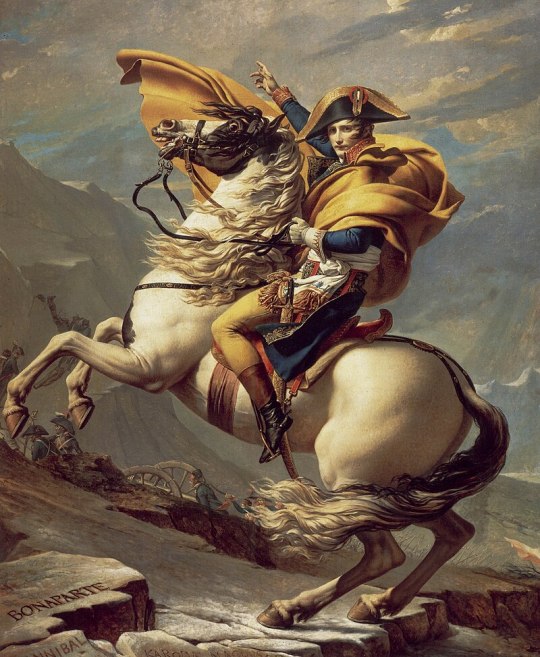
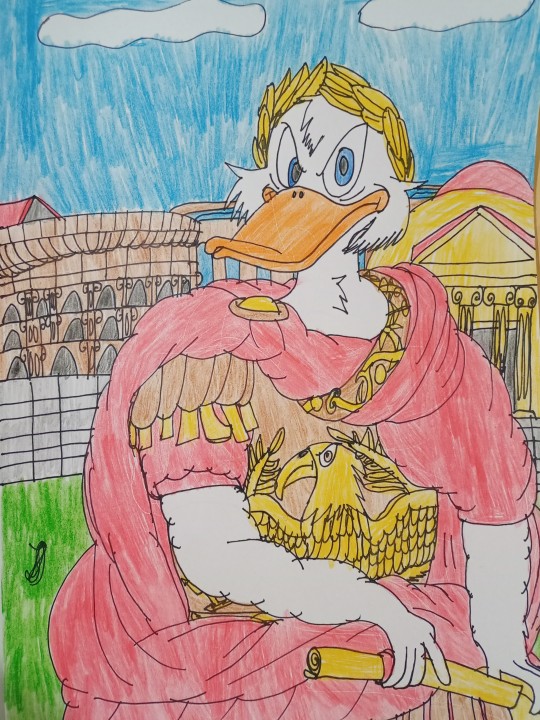
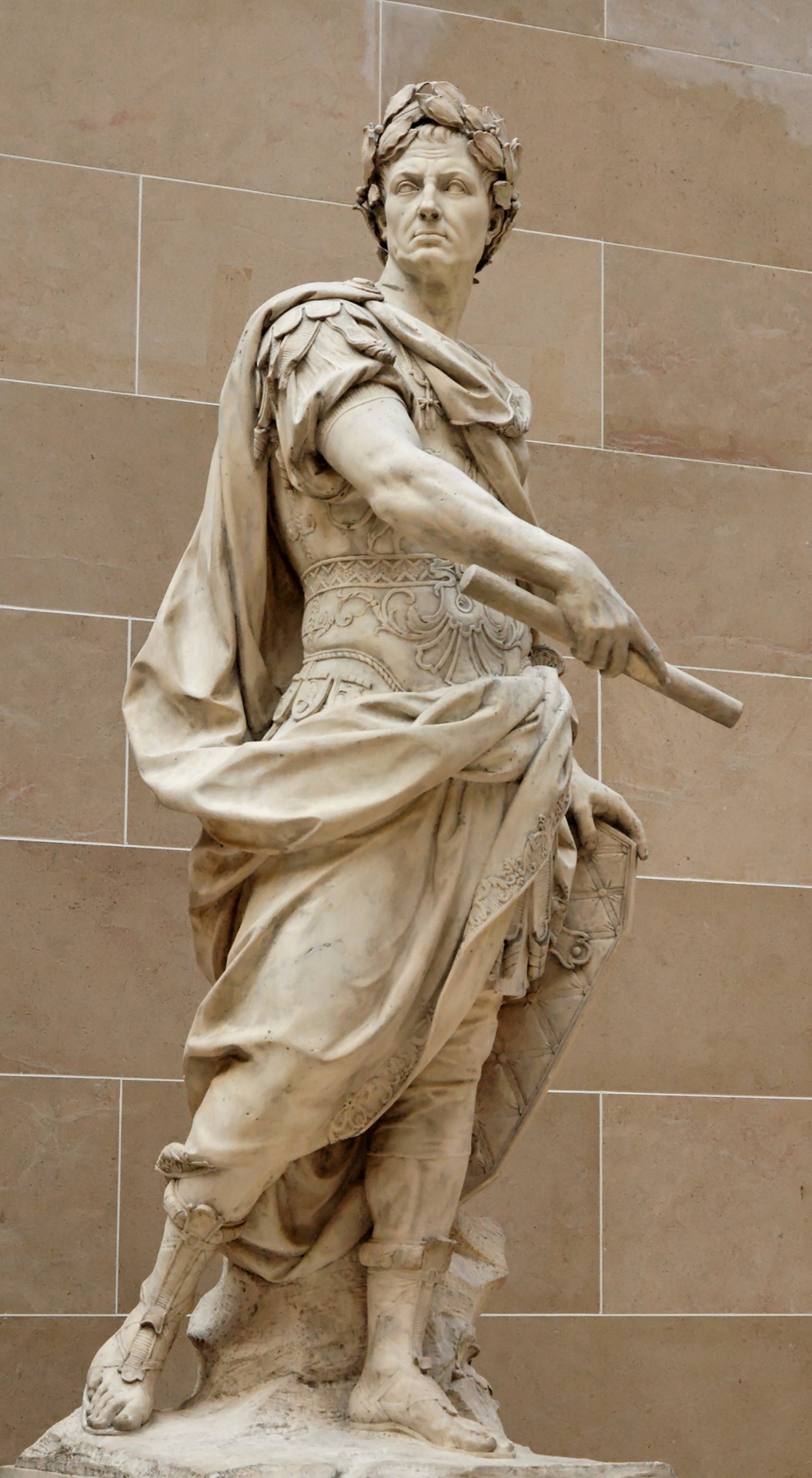
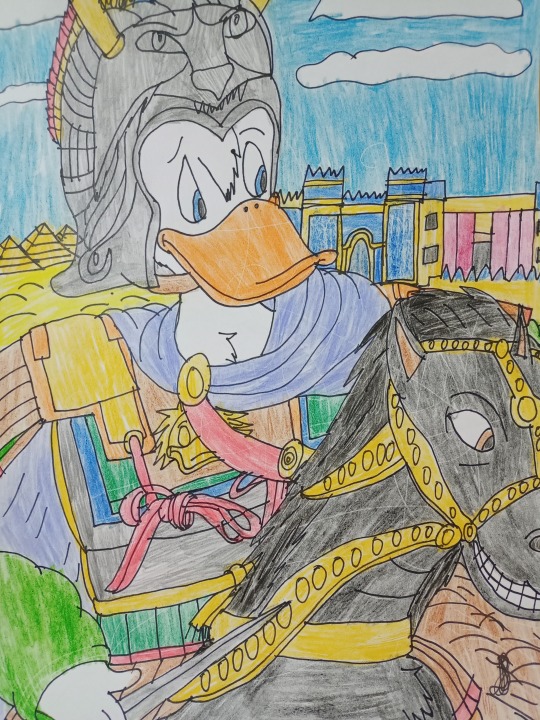
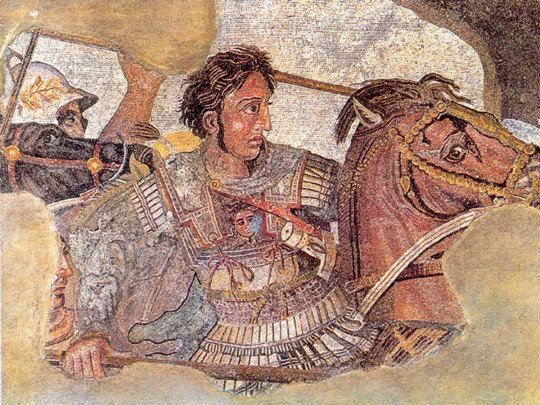
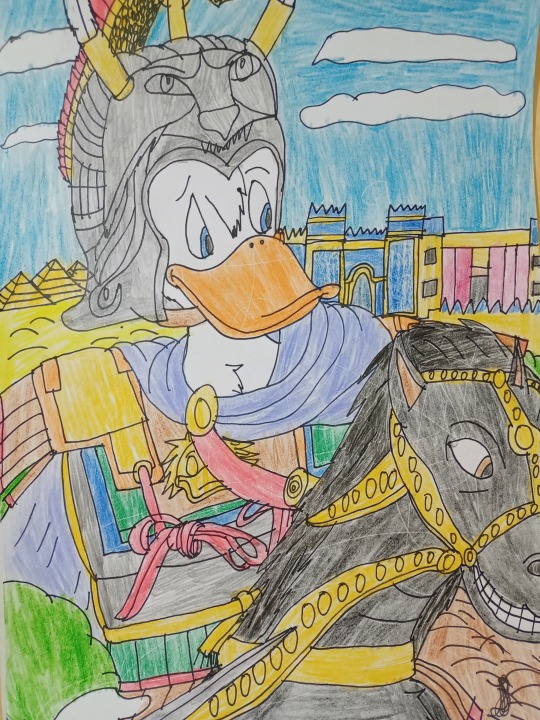
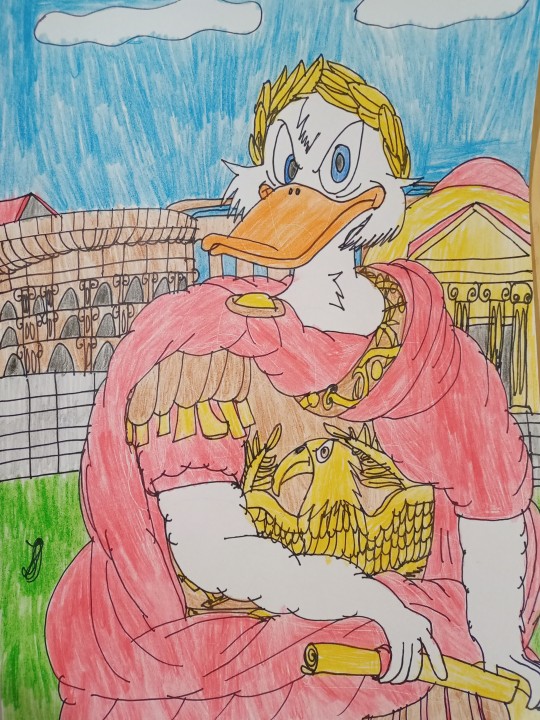
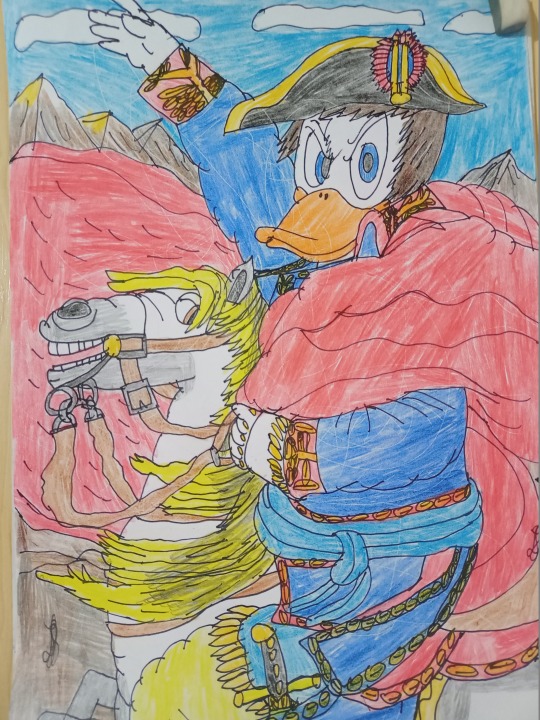
Donald Duck as Napoleon Bonaparte, Scrooge McDuck as Gaius Julius Caesar and Louie Duck (Quack Pack) as Alexander the Great - Conquerors - Real Ducks in History - History in Duckverse
I've always wanted to do a special project called Duckverse in History and my plan is to draw my favorite characters as redraws from famous works of art as well as famous historical figures. And since history is my favorite science, and my favorite field, I definitely wanted to do something related to it and related to one of my favorite historical characters. Since I don't want to complicate the situation, I will gradually publish a drawing related to that historical figure from time to time. I started this last year for Duckvember only to finish at the end of last month.
The first drawing is a redraw from Jacques Louis David's famous early 19th century artwork depicting Napoleon Bonaparte crossing the Alps in 1800 before the Battle of Marengo. Napoleon Bonaparte was the most famous French military leader, general, consul and emperor who waged war with all of Europe at the time and managed to subjugate it in its entirety except for the Ottoman Empire, Russia and Great Britain. He is from Corsica, but he left a lot for France and proved that France is not worth messing with easily. He also gave many reforms and his Civil Code which spread throughout Europe and brought order in France after the French Revolution. Napoleon's nature is very similar to Donald Duck and I drew Donald as Napoleon since he was created for that role and I drew him riding his horse Marengo in my own style, but in a realistic way and that Donald has five fingers.
The second drawing is a redraw of a statue made by Nicolas Coustou at the end of the 17th century for the decoration of Versailles, which depicts the greatest Roman, Gaius Julius Caesar. Although he was not an emperor, certainly many presented him, but he was a dictator, consul, general, writer, historian, engineer, constructor, and a great military leader who changed the Roman Republic into an almost Roman Empire. His fights against the Gauls, as well as the conflict with Pompey and his love with Cleopatra, are known, but he also changed a lot in Rome and was extremely rich. And he lived during the first century BC. That's why I drew Scrooge McDuck as Gaius Julius Caesar since Scrooge is a great leader and he also strived for fame and fortune and to be remembered in the future and he plays the role of the best Roman. Behind it are the Colosseum (built a century after him), the aqueduct (then irrigation) and the Pantheon (built two centuries after him), as well as a Roman temple that symbolizes Rome at that time, as well as the roads themselves. In addition, Topolino (Italian comics) are showed Scrooge as Caesar two or three times so that's where my inspiration came from.
The third drawing shows Louie Duck (the Quack Pack version, not the Ducktales reboot) shows Alexander the Great, another brilliant conqueror from the fourth century BC and I drew it as a redraw from the mosaic of Alexander the Great from the battle of Issus in which he confronts the Persian king Darius III from Pompeii, probably from the first century BC. Alexander the Great was the son of Philip II and the king of Macedonia who united Greece and fought against Persia and managed to conquer an entire empire in his twenties. He traveled through the Persian Empire and reached India and wanted to continue, but his soldiers did not want to continue, so he returned to Babylon, his new capital. He certainly changed the world at that time and introduced a new culture, called Hellenism, as a combination of ancient Greek culture and the culture of the Ancient East and ancient India. I drew Louie as Alexander because as a young man he is a great adventurer and rides his black horse Bucephalus and is eager for extremes, yet unlike Alexander, Louie shows a bit of his shyness, but is still brave enough to take on new challenges. I also added a helmet as worn by Alexander III in his time. Behind Louie are the pyramids from Egypt, the Ishtar Gate from Babylon and the imperial palace from Persepolis where the Persian rulers lived and it actually shows the lands that Alexander the Great conquered.
I certainly hope you like these drawings and these ideas and that these characters have such historical roles. Of course, Duckverse in history I combine mostly everything related to Duckverse (Donald Duck comics, OG Ducktales, Three Caballeros, Darkwing Duck and Quack Pack) and it's mostly my version and my idea. By all means if you like this and support these ideas, feel free to like and reblog this, but please don't use these same ideas without mentioning me and without my permission. Thank you!
#my fanarts#traditional art#artists on tumblr#donald duck#history#duckverse#ducktales#napoleon bonaparte#gaius julius caesar#alexander the great#scrooge mcduck#louie duck#quack pack#disney ducks#duckverse in history#disney duck comics#rome#france#topolino#greece#disney duckverse#quack pack au#art#my redraws#the conquerors#my fanart#comics#cartoons#my style#julius ceaser
36 notes
·
View notes
Text
Bethesda Terrace

Bethesda Terrace and surrounding areas:
Wedding and Engagement Photos: Bethesda Terrace is a popular spot for wedding and engagement photoshoots due to its romantic ambiance and picturesque setting. The elegant architecture and the angel-topped fountain make for stunning backdrops for these special occasions.
Four Seasons: Bethesda Terrace offers a different experience in each season. In the spring, the terrace is surrounded by blooming flowers, while in the fall, the changing leaves create a vibrant and colorful landscape. During the winter, the terrace can be especially enchanting when covered in snow, and the fountain is occasionally frozen.
Ice Skating: In the colder months, Central Park's Wollman Rink, located just a short walk from Bethesda Terrace, offers ice skating. Skating in this idyllic setting with the terrace in the background is a beloved winter activity for locals and visitors alike.
Central Park Conservatory Garden: Located to the north of Bethesda Terrace, the Central Park Conservatory Garden is a beautifully landscaped formal garden with various themed sections, including Italian, French, and English gardens. It's a tranquil oasis within the park and is worth exploring if you're in the area.
Bethesda Terrace in Popular Culture: Apart from its appearances in movies and music videos, Bethesda Terrace has been featured in various television shows and commercials. Its iconic status in popular culture has made it a recognizable symbol of Central Park worldwide.
Preservation Efforts: The preservation of Bethesda Terrace and other historic structures in Central Park is an ongoing effort. Conservationists work tirelessly to maintain the terrace's original character and ensure its longevity for future generations to enjoy.
Public Art and Events: The area surrounding Bethesda Terrace often hosts temporary public art installations and cultural events. These events add an extra layer of vibrancy and creativity to the terrace's atmosphere.
Central Park's Role in the Community: Bethesda Terrace, along with the rest of Central Park, plays a crucial role in the lives of New Yorkers. It serves as a space for relaxation, exercise, cultural events, and community gatherings, providing a respite from the bustling city streets.
Whether you're visiting Central Park for its natural beauty, historical significance, cultural events, or simply to take in the sights and sounds of the city, Bethesda Terrace remains a timeless and enchanting destination that captures the essence of this iconic urban park.
Angel of the Waters: The sculpture atop the Bethesda Fountain, known as the "Angel of the Waters," is not only a beautiful work of art but also carries symbolic significance. It represents the healing powers of water, which aligns with the terrace's proximity to the Central Park Lake and the Ramble.
Wedding Proposals: Due to its romantic setting and picturesque backdrop, Bethesda Terrace is a popular spot for marriage proposals. Many couples choose this location to pop the question, making it a memorable and sentimental place for them.
Central Park Zoo: Just a short walk from Bethesda Terrace is the Central Park Zoo. It's a family-friendly attraction that houses a variety of animals and offers educational programs for visitors of all ages. It's a great place to complement your visit to the terrace.
Artists and Street Performers: Bethesda Terrace often attracts artists and street performers who set up their easels, create artwork, or showcase their talents, adding to the artistic atmosphere of the area.
Boat Rentals: Nearby Loeb Boathouse offers rowboat and gondola rentals for a serene experience on the Central Park Lake. Paddling around the lake can be a relaxing and enjoyable way to spend time in the park.
Historical Significance: Bethesda Terrace is not only a beautiful architectural feature but also a piece of New York City history. It has been a gathering place for generations of New Yorkers and remains a symbol of the enduring allure of Central Park.
Views and Photography: The terrace offers some of the best views in Central Park, whether you're looking out over the lake or capturing the intricate architectural details of the terrace itself. It's a fantastic location for photography enthusiasts.
Restaurants and Dining: The Central Park Boathouse Restaurant, located adjacent to the terrace, offers both casual and fine dining experiences with a view of the lake. It's a great place to enjoy a meal while taking in the park's beauty.
In conclusion, Bethesda Terrace in Central Park is a multifaceted destination that appeals to a wide range of interests and activities. Whether you're seeking relaxation, cultural enrichment, natural beauty, or a touch of romance, this iconic spot within Central Park has something to offer everyone who visits.
Bethesda Terrace Read more
#Bethesda Fountain#New York City#new york#newyork#New-York#nyc#NY#manhattan#urban#city#USA#buildings#visit-new-york.tumblr.com#outdoors#journey#street#architecture#Bethesda Terrace#Central Park
282 notes
·
View notes